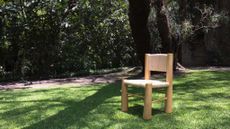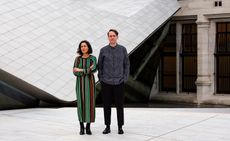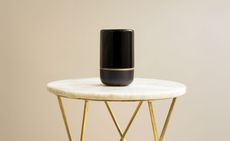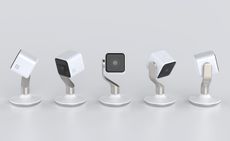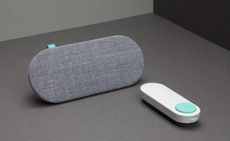Yves Béhar-designed underwater research station is inspired by 1960s design
Yves Béhar and his firm Fuseproject have collaborated with ocean conservationist Fabien Cousteau to design an underwater scientific research habitat of the future
- (opens in new tab)
- (opens in new tab)
- (opens in new tab)
- Sign up to our newsletter Newsletter
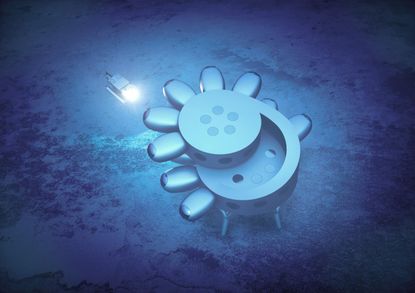
To the unfamiliar, the world of subsea research is weighed down by an ageing image of bright yellow bathyscaphes and soggy woollen berets. Although polar regions have recently received a major fillip in design distinction, serious underwater architecture has been overlooked, with only eyeball-snaring forays into restaurants and hotels surfacing.
Proteus is a new venture into design for the deep, overseen by Yves Béhar’s fuseproject studio for a very distinguished client, the filmmaker and ocean conservationist Fabien Cousteau, grandson of the celebrated Jacques Cousteau. A proposed HQ for the Fabien Cousteau Ocean Learning Center, Proteus is designated to sit on a plot about 18m beneath the waves just off the Caribbean island of Curaçao.

Proteus early sketches
The project has been a couple of years in the making. ‘Early in the project two years ago, Fabien Cousteau and I looked at many exploratory designs from the 1960s and 70s,’ Béhar explains, ‘it was a golden era of interest for the oceans pioneered by the Cousteau family history.’ The brief was to develop Proteus using new materials, especially composites, and create what Béhar calls a ‘a state-of-the-art scientific environment with a comfortable social interior space.’
‘I have always had a strong connection and appreciation for the ocean. There’s a respect for the ocean – its power and its mystery.’
This kind of lab is essential for long-term research, as they allow divers to become acclimatised to undersea pressures. Proteus is a modular design with space for up to 12 people at a time. ‘The technology to make Proteus a reality is here, from fabrication coming from modern hull design and the use of composite materials to sustainably powering the station with a mix of renewable sources including wind, solar and Ocean Thermal Energy Conversion (OTEC),’ Béhar explains. For Cousteau, a permanent underwater research station is a lifelong ambition, one that aligns with a lifetime of involvement with studying and conserving ocean habitats. Béhar is totally on board with the ethos. ‘As a California resident and long-time surfer, I have always had a strong connection and appreciation for the ocean. There’s a respect for the ocean – its power and its mystery.’

Ultimately, the Proteus station is projected to be around 4,000 sq ft, over three times larger than any other undersea habitat. Béhar’s early sketches show an organic circular structure, anchored to the seabed on legs, with a spiralling ramp connecting two principal cylindrical spaces. Mounted off the spiral are living and working pods, giving the facility the look of a piece of growing coral or an exotic shell. The winding ramp houses the common spaces, including the living room and galley and there’s also a moon pool, an open water dock for submersibles. Béhar is particularly proud of the inclusion of a ‘greenhouse’, a potentially vital source of fresh food for a habitat where open flames are banned. ‘The larger area is where scientists and aquanauts spend most of their indoor worktime. These are open and convivial as being underwater for weeks can be isolating,’ says Béhar, adding that the ramp is also a good spot for exercising.
There are still details to finesse. ‘Most of the technology is available today, but some will have to be created as we go forward,’ says Cousteau, ‘For example, the submarine coupling needs to be determined. It's a little like the International Space Station, when you have to couple other vessels to it. We have the same issue down below, but instead of the vacuum of space, we have to deal with the multiple atmospheres, or pressures, of water. It is also dependent on the type of sub used.’ Cinematic in scope and scale, Cousteau and Béhar are hoping that Proteus brings fresh awareness of the issues facing the ocean, as well as providing a platform for ongoing discovery.

Proteus early sketches
INFORMATION
fuseproject.com (opens in new tab)
fabiencousteauolc.org (opens in new tab)
Jonathan Bell has written for Wallpaper* magazine since 1999, covering everything from architecture and transport design to books, tech and graphic design. He is now the magazine’s Transport and Technology Editor. Jonathan has written and edited 15 books, including Concept Car Design, 21st Century House, and The New Modern House. He is also the host of Wallpaper’s first podcast.
-
 This winter’s most stylish skiwear, Gucci to Hermès
This winter’s most stylish skiwear, Gucci to HermèsStatement-making skiwear for on and off the slopes, from Louis Vuitton, Dior, Moncler and more
By Jack Moss • Published
-
 Clásicos Mexicanos celebrates Mexican design’s golden age
Clásicos Mexicanos celebrates Mexican design’s golden ageDesign Miami 2022: the Maestro Dobel Artpothecary in collaboration with Clásicos Mexicanos features works from Mexican architect Ricardo Legorreta’s ‘Vallarta’ collection
By Sujata Burman • Published
-
 HTL Africa imagines architecture as an ‘object of performance’
HTL Africa imagines architecture as an ‘object of performance’HTL from Nigeria is next up in our series of profiles of architects, spatial designers and builders shaping West Africa’s architectural future
By Ijeoma Ndukwe • Published
-
 Yves Béhar designs robot called Moxie, a companion for the curious child
Yves Béhar designs robot called Moxie, a companion for the curious childWe chat to San Francisco-based designer Yves Béhar about Moxie, a new robot designed by fuseproject and made by Embodied Inc using the very latest form of AI
By Jonathan Bell • Last updated
-
 Yves Béhar takes Hive outdoors with a new home security camera
Yves Béhar takes Hive outdoors with a new home security cameraBy Elly Parsons • Last updated
-
 Next stop: are smart homes making us stupid?
Next stop: are smart homes making us stupid?By Elly Parsons • Last updated
-
 Muscle suits, Bitcoin miners and artificial leaves descend on the V&A in a technology takeover
Muscle suits, Bitcoin miners and artificial leaves descend on the V&A in a technology takeoverBy Elly Parsons • Last updated
-
 The all-hearing Hive Hub 360 hits shelves
The all-hearing Hive Hub 360 hits shelvesBy Elly Parsons • Last updated
-
 Eye spy: Yves Béhar’s Hive View is an all-seeing addition to the smart home
Eye spy: Yves Béhar’s Hive View is an all-seeing addition to the smart homeBy Jonathan Bell • Last updated
-
 Moving pictures: Samsung and Yves Béhar create an artful television concept
Moving pictures: Samsung and Yves Béhar create an artful television conceptBy Rosa Bertoli • Last updated
-
 Technically speaking: how designers are putting the home back into home tech
Technically speaking: how designers are putting the home back into home techOur monthly dissection of the best design-minded technology happenings the world over
By Elly Parsons • Last updated

